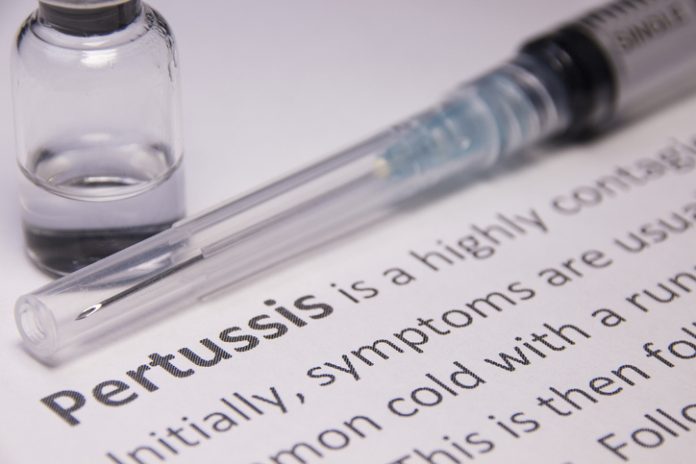By Erwin Haas, M.D.
Two elderly spinsters, Grace Eldering (1900-1988) and Pearl Kendrick(1890-1980) lived together in a small house in Comstock Park, a down-market suburb of Grand Rapids, Michigan. They developed the first successful whooping cough vaccine.
I saw Grace a year before she died. She seemed anxious to talk to someone who somewhat understood the infection as well as the immunization practices. I spent some time listening to this pleasant and iconic figure.
There is an excellent history of how two women developed the original whooping cough immunization. It leaves unexplained what got them making a whole-cell vaccine and how they managed to get so much free cooperation.
The Mother of Invention
The women both had had whooping cough in childhood and had grim memories of the experience. The infection (called pertussis in medical circles) caused widespread community outbreaks before 1948.
The bacteria is extremely contagious. It infects all age groups but in infants and very young children, it can lead to death and, in the long-term, damage lungs producing slow lung destruction and bad breath. In the 1930s it killed around 6,000 children each year. It causes adults to have a chronic cough that is not otherwise damaging to their health and identifies them as carriers.
The State of Michigan had established four laboratories, one of which was in Grand Rapids. Doctors and public health officials in the area sent them cultures of contagious diseases such as typhoid, cholera, and pneumonia as well as dairy and food surveillance samples at a time when ordinary hospitals did not have this capability.
Kendrick and Eldering undertook to help local physicians, mainly pediatricians and ENT specialists (who were very prominent 100 years ago) contrive a way to treat the “Michigan sinus.” Doctors would send swabs from afflicted patients to the lab which the two investigators would culture. After growth, colonies of bacteria, mainly ordinary streptococci and staphylococci, were harvested, exposed to Merthiolate, which killed the bacteria and left the surfaces of the bugs exposed as antigens.
The women would send the resulting concoction back to the referring physicians who would inject the brew into their patients causing a moderate to a severe inflammatory reaction. The resulting stress elicited hydrocortisone and epinephrine secretion which calmed the “Michigan sinus.” (Don’t try this!)
Now, to the Lab
One day shortly after meeting in 1932, they decided to do something significant and applied the same procedure to a strain of pertussis that they had just cultured in their laboratory. Eldering and Kendrick gave each other the vaccine as a rough test for safety and then contacted the physicians with whom they routinely worked and asked them to immunize children in their practices with this vaccine.
This seemed to work, and over the next several years they worked with the Public Health Service in the Grand Rapids area to immunize 5800 children who attended a vaccination clinic. The women established a control group of similar children who are not immunized and personally saw and cultured most of the study’s cases of whooping cough.
After three years, the women could show the immunized children had only a minuscule possibility of developing whooping cough versus the unimmunized children. Their 1939 paper caused a sensation. Researchers from Harvard and Hopkins became involved. Over the next decade during the depression and World War II, despite only meager financial support, the women continued developing their vaccine, finding more immunogenic strains, exploring different concentrations of their vaccine, and better methods to measure the protection that it conferred.
Elderlng and Kendrick combined their vaccine with diphtheria, and tetanus vaccines, and this combination was accepted by the World Health Organization in 1948. Their whole-cell preparation remained a standard in these immunizations for the next 45 years.
Trial and Error
From the beginning, the whole bacteria vaccine had several problems. In a tiny minority of children, it caused seizures, in others a high fever and yet in others a day or two of continuous screaming, all of which was very disturbing to parents. None of the short-term complications ever led to long-term problems. In the early years, it was widely understood that they were very acceptable compared to having potentially lethal childhood whooping cough. The vaccine generally protected children for five years and was first given shortly after birth.
The vaccines were acceptable despite their toxicities to people who could remember having outbreaks of whooping cough and deaths but by the 1980s this was forgotten, and many parents refused to have their children immunized. There were huge outbreaks of whooping cough.
There followed the development in 1996 of the second pertussis vaccine, the aqueous, which contained only some humors from the whole cell. This vaccine does not have the complications of seizures, crying spells, and fevers that characterized the original vaccine, but it only protects people for three years and it is thought to allow individuals to transmit the disease to others although they themselves are protected.
Needs Improvement
Having to give the first booster at age three years is at an interval that is not very compatible with ordinary pediatric immunization practices. They can get their second booster when they enter school for a few more years of protection but then need a booster again. The aqueous pertussis vaccine protects for too short a time to do the job that the original vaccine did so well.
So after nearly 90 years of developing a vaccine against a bacteria we can grow in any hospital laboratory, pertussis vaccination still falls short. We are still seeking a better vaccine after an 89-year effort created in part by the life’s work of two gifted women, by the results documented as billions of individuals received multiple doses, and where every minor aberration is investigated by a malpractice lawyer.
Erwin Haas, M.D., MBA, is an infectious disease consultant, a veteran flight surgeon in Vietnam, and policy advisor to The Heartland Institute. A version of this article appeared in American Thinker on April 21, 2021. Reprinted with permission.




















